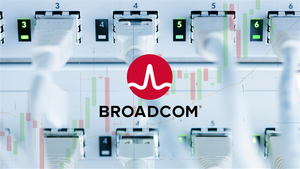
In a stunning display of market confidence, Oracle Corporation's (NYSE: ORCL) stock experienced an unprecedented surge of over 40% in a single day, marking its most significant single-day rally since 1999. This monumental jump, which propelled the company's market capitalization towards the $1 trillion mark, was triggered by the announcement of a record-breaking $455 billion in Remaining Performance Obligations (RPO). This colossal backlog is overwhelmingly attributed to a series of massive AI cloud deals with some of the biggest names in technology, including OpenAI, xAI, Meta (NASDAQ: META), NVIDIA (NASDAQ: NVDA), and AMD (NASDAQ: AMD). The market's reaction signals a profound re-rating of Oracle, positioning it as a critical infrastructure provider in the rapidly expanding and "gigantic, multi-trillion-dollar market" for AI inference.
This extraordinary financial event signifies more than just a stock market rally; it represents a strategic pivot for the enterprise software behemoth, firmly establishing Oracle Cloud Infrastructure (OCI) as a major contender in the high-stakes AI cloud race. The sheer scale of the contracted revenue indicates a robust, multi-year pipeline for AI-related services, fundamentally reshaping Oracle's growth trajectory and its role in powering the next wave of technological innovation.
The AI Cloud Tsunami: What Happened and Why It Matters
Oracle's historic stock surge of over 40% occurred following its first-quarter fiscal year 2026 earnings report, which concluded on August 31, 2025. While the company's reported quarterly earnings and revenue were slightly below Wall Street estimates, investors largely overlooked these misses, instead focusing intensely on the "aggressive growth outlook tied to AI and cloud demand" presented by Chairman and CTO Larry Ellison and CEO Safra Catz. The stock price soared to approximately $334.47, increasing Oracle's market capitalization by an estimated $200 billion to reach around $940 billion.
The primary catalyst for this meteoric rise was the revelation of an "astonishing" 359% year-over-year increase in Remaining Performance Obligations (RPO), totaling a record $455 billion. RPO represents the total value of contractual obligations not yet recognized as revenue, serving as a crucial forward indicator of booked revenue and future income from customer agreements. This figure far exceeded analyst expectations, which were around $180 billion, and represents a jump of $317 billion from the end of the previous fiscal quarter. Oracle's cloud RPO alone saw nearly 500% growth, underscoring the immense and secured demand for OCI, particularly for AI training and inference workloads.
Oracle's leadership detailed that this monumental RPO includes four multi-billion-dollar contracts signed with three different customers in the first quarter alone, with expectations to secure several more such deals in the coming months. Key clients explicitly mentioned as part of this "who's who of AI" include OpenAI, xAI, and Meta. Notably, OpenAI reportedly sealed a massive deal with Oracle, potentially valued at over $30 billion annually, for data center capacity as part of its ambitious "Stargate" project, an expansion of Microsoft Azure AI platform to OCI for additional capacity. NVIDIA (NASDAQ: NVDA) and AMD (NASDAQ: AMD) were also cited as crucial partners and customers, benefiting from Oracle's extensive AI infrastructure buildout. Larry Ellison emphasized Oracle's focus not just on AI training but, more significantly, on AI inference, which he believes will be the fastest-growing workload and the largest opportunity in the "gigantic, multi-trillion-dollar market."
Initial market reactions were overwhelmingly positive, with analysts expressing shock and excitement. TD Cowen analysts described it as "arguably the most momentous" quarter in Oracle's history, calling the figures "astonishing" and a "career event." Price targets for Oracle stock were significantly raised across the board. The surge had a ripple effect, boosting broader tech sentiment and leading to gains in the stocks of chipmakers like NVIDIA and AMD, reflecting the market's strong appetite for foundational "picks and shovels" providers in the AI gold rush. Oracle's ambitious growth forecast includes projecting its cloud infrastructure revenue to reach $18 billion in the current fiscal year (2026), a 77% jump, and further accelerate to $144 billion by 2030, solidifying its position among the major cloud providers alongside Amazon Web Services (AWS) (NASDAQ: AMZN), Microsoft Azure (NASDAQ: MSFT), and Google Cloud (NASDAQ: GOOGL).
The Shifting Landscape: Winners and Losers
Oracle's dramatic entry into the forefront of AI cloud infrastructure is creating a dynamic shift, ushering in a new era of winners and presenting new challenges for existing players.
The most evident winner is Oracle (NYSE: ORCL) itself. The company's stock surge reflects investor confidence in its strategic pivot and ability to capture a substantial share of the AI infrastructure market. Oracle projects its cloud infrastructure revenue to reach $18 billion this fiscal year and an ambitious $144 billion over the next four years, indicating robust financial growth. Its enhanced market position is transforming OCI from a niche player to a significant contender, increasingly viewed as a "go-to place for AI workloads." Oracle's strategic advantages, including its distributed cloud architecture, strategic alliances, and cost-efficient infrastructure, particularly its networking architecture using RoCEv2 for ultra-low-latency communication, are proving highly attractive. Furthermore, its strategy of not developing its own large-scale AI models offers a neutral and appealing platform for AI developers who might view other hyperscalers as competitors. While facing risks like high capital expenditure and the challenge of sustaining momentum, the current trajectory is undeniably positive for Oracle.
Oracle's AI Partners are also riding this wave of success. OpenAI, a cornerstone partner, gains critical resources and enhanced infrastructure resilience through its multi-billion-dollar cloud services agreement with Oracle for the "Stargate" project. xAI, Elon Musk's AI startup, and Meta Platforms (NASDAQ: META) have also signed multi-billion-dollar contracts, leveraging OCI for their demanding AI workloads. These partnerships highlight OCI's growing appeal as a flexible and powerful AI infrastructure provider. Chipmakers NVIDIA (NASDAQ: NVDA) and AMD (NASDAQ: AMD) are major beneficiaries. Oracle is investing heavily in NVIDIA's hardware, housing 65,000 NVIDIA H200 GPUs and planning for a Zettascale supercomputing cluster with over 131,072 Blackwell GPUs. Similarly, Oracle's deployment of thousands of AMD Instinct MI300X GPUs provides AMD with significant traction in the competitive AI chip market. Both companies saw their shares boost following Oracle's strong earnings and outlook, reflecting increased demand for their semiconductors in data centers.
For Cloud Competitors like Amazon Web Services (AWS) (NASDAQ: AMZN), Microsoft Azure (NASDAQ: MSFT), and Google Cloud (NASDAQ: GOOGL), Oracle's aggressive push into AI cloud creates a more intense competitive environment. While these hyperscalers collectively dominate the cloud market, Oracle's specialized focus on high-performance AI infrastructure and its "neutrality" could divert a segment of the high-growth AI workload market. However, the situation is nuanced; Oracle is also engaging with its rivals through multi-cloud partnerships. Revenue from these multi-cloud database partnerships, which allow customers on AWS, Azure, and Google Cloud to run Oracle Cloud Infrastructure alongside native services, surged over 1,500% in Q1. This positions Oracle not merely as a competitor but also as an enabler within rival ecosystems, making its specialized services indispensable even to its largest competitors. While the overall demand for AI infrastructure is lifting the entire cloud sector, Oracle's new projected growth trajectory intensifies competition, forcing existing giants to adapt to a more specialized AI infrastructure market.
Industry Impact and Broader Implications
Oracle's AI cloud surge represents a pivotal moment, deeply interwoven with, and amplifying, several critical industry trends. It underscores the insatiable demand for high-performance AI infrastructure and signals a significant strategic shift within the cloud computing landscape.
This event is a clear manifestation of the intense demand for AI infrastructure. The global race to develop and deploy advanced AI models requires unprecedented computing power, driving massive investments in data centers and specialized hardware like GPUs. Companies are scrambling to secure the necessary resources, and Oracle's ability to provision "gigawatt-scale data centers" equipped with NVIDIA (NASDAQ: NVDA) chips, optimized for AI training, directly addresses this critical need. The monumental scale of deals with AI leaders like OpenAI highlights OCI's newfound capacity and appeal as a foundational AI infrastructure provider.
Crucially, Oracle's leadership, particularly Larry Ellison, is emphasizing a strategic focus on AI inference. While much of the initial AI investment has been in training large language models, the deployment of these models at scale for real-world applications—inference—is projected to become a multi-trillion-dollar market that could eventually "dwarf" the training market. Oracle is positioning OCI for this shift, offering infrastructure for both training and deploying AI inference applications, including integrating NVIDIA NIM microservices. This forward-looking strategy positions Oracle to capitalize on the next major phase of AI adoption.
The ripple effects on competitors are profound. While AWS (NASDAQ: AMZN), Microsoft Azure (NASDAQ: MSFT), and Google Cloud (NASDAQ: GOOGL) continue to dominate the broader cloud market, Oracle's specialized approach and "neutrality" in not developing its own large AI models make it an attractive alternative for AI developers who might see the hyperscalers as potential competitors. Interestingly, Oracle's multi-cloud strategy fosters a unique dynamic of co-opetition. Its multi-cloud database revenue, which allows Oracle Database services to run within rival cloud platforms, surged by an astonishing 1,529% in Q1. This means Oracle is not just competing but also enabling its rivals, making its core database and specialized AI infrastructure an essential component of many enterprise multi-cloud strategies.
In terms of regulatory and policy implications, the rapid growth and increasing concentration of power among major cloud and AI providers, including Oracle, are drawing scrutiny. Regulators worldwide are examining market concentration, data sovereignty, and the potential for exclusive agreements to stifle competition. Oracle's expansion of its distributed cloud with data centers globally, particularly in regions like the EU, helps address stringent data privacy laws and "sovereign AI" requirements, where AI infrastructure and data processing must comply with local regulations. Furthermore, compute providers are increasingly seen as having a crucial intermediary role in AI regulation, acting as record keepers, verifiers, and enforcers of AI policies.
Historically, Oracle's surge draws parallels to NVIDIA's explosive growth in the AI chip market. Both companies are now seen as fundamental "picks and shovels" providers in the AI gold rush, benefiting from the immense demand for underlying infrastructure. Just as NVIDIA dominates AI chips, Oracle is establishing itself as a leading provider of the cloud infrastructure to run those chips and AI models. This current boom, while drawing comparisons to past tech bubbles, is seen by many as driven by a more robust and pervasive fundamental value proposition of AI, solidifying the "winner-take-most" nature of new, capital-intensive markets where well-resourced tech giants are best positioned to thrive.
What Comes Next
Oracle's seismic shift into the AI cloud infrastructure market heralds a future of aggressive growth and intensified competition. The coming months and years will be crucial in determining the long-term impact of this strategic pivot for Oracle and the broader tech landscape.
In the short-term, Oracle's Cloud Infrastructure (OCI) revenue is expected to continue its rapid acceleration. The company forecasts OCI revenue to grow 77% to $18 billion in the current fiscal year (FY26). This growth will be fueled by the ongoing deployment of massive AI SuperComputers, capable of scaling up to 65,000 NVIDIA (NASDAQ: NVDA) H200 GPUs, and the delivery of existing multi-billion-dollar contracts. A significant event to watch is the anticipated launch of the "Oracle AI Database" service in October. This service aims to allow customers to seamlessly integrate leading AI models like ChatGPT, Grok, and Gemini with their Oracle Databases, leveraging Oracle's core strengths in data management for advanced AI inference and analytics. Oracle must also rapidly expand its data center footprint and address potential capacity constraints to meet the surging demand for AI workloads.
Long-term, Oracle has laid out an ambitious growth trajectory, projecting OCI revenue to reach $144 billion by fiscal 2030. This fourteen-fold increase from its current annual run rate would significantly disrupt the existing cloud hierarchy. Oracle's strategy of being a "neutral platform"—not developing its own large-scale AI models—is expected to remain a key differentiator, attracting AI developers like OpenAI and Cohere who seek raw computing power without competitive threats from their cloud provider. The company's heavy investment in "gigawatt scale data centers" optimized for AI training underscores a sustained commitment to becoming a foundational "AI utility." However, this massive capital expenditure, projected to exceed $35 billion for FY26, will require careful management to balance growth with profitability.
Potential strategic pivots or adaptations will be necessary for all players. Oracle will need to continue its aggressive investments in AI infrastructure, while also deepening its multi-cloud strategy and integrating AI capabilities across its entire software stack. For its competitors—AWS (NASDAQ: AMZN), Microsoft Azure (NASDAQ: MSFT), and Google Cloud (NASDAQ: GOOGL)—the focus will be on intensifying their own AI initiatives, developing custom chips, and innovating at the platform and application layers to differentiate themselves. All hyperscalers will likely enhance multi-cloud and hybrid cloud offerings to address enterprise needs for flexibility, data sovereignty, and compliance. The overall market will see increased specialization, with Oracle carving out a powerful niche in high-performance AI compute.
Market opportunities are immense, driven by the generative AI boom, which is expected to propel cloud computing sales to $2 trillion by 2030, with generative AI accounting for a substantial portion of that. Opportunities abound in enterprise AI adoption for workflow automation, data analytics, industry-specific solutions (e.g., healthcare AI projected at a 35.61% CAGR), and the democratization of AI through low-code/no-code platforms. However, challenges are equally significant, including the high costs and capital expenditure required for AI infrastructure, data privacy and security concerns (almost 97% of organizations have experienced generative AI-linked breaches), talent shortages, and the complexity of integrating AI with existing systems. Ethical concerns, regulatory compliance, and the risk of vendor lock-in will also remain critical challenges.
Potential scenarios for the cloud and AI market include further hyperscaler consolidation and specialization, with Oracle solidifying its niche as a critical backend for AI development. The emergence of an "AI Supercloud" offering flexible, on-demand GPU resources could become prominent. Hybrid and multi-cloud strategies are set to dominate, emphasizing data-centric AI and enhanced cybersecurity through AI-driven automation. Over the long term, emerging technologies like quantum computing, while nascent, could fundamentally alter the computational landscape.
A New Era for Oracle: The AI Infrastructure Powerhouse
Oracle's recent spectacular stock surge, driven by an astounding $455 billion in Remaining Performance Obligations from massive AI cloud deals, marks a watershed moment in the company's long history. It fundamentally redefines Oracle's identity, transforming it from a venerable enterprise software and database provider into a leading "AI utility" and a critical powerhouse in the global AI infrastructure build-out. This is not merely a transient market reaction but a momentous confirmation of Oracle's strategic foresight and technological capabilities in capturing the heart of the artificial intelligence revolution.
The key takeaway is that Oracle Cloud Infrastructure (OCI) has become an indispensable backbone for the world's most demanding AI workloads. Its ability to provide high-performance, cost-effective, and "neutral" cloud compute—meaning it doesn't compete with its AI clients by developing its own large language models—has proven incredibly attractive to innovators like OpenAI, xAI, and Meta (NASDAQ: META). This strategic positioning, coupled with aggressive investments in gigawatt-scale data centers and partnerships with chip giants like NVIDIA (NASDAQ: NVDA) and AMD (NASDAQ: AMD), firmly places Oracle (NYSE: ORCL) at the epicenter of the "gigantic, multi-trillion-dollar market" for AI, particularly in the burgeoning field of AI inference. The company's impressive projections for OCI revenue, aiming for $144 billion by 2030, underscore a new, accelerated growth trajectory that few could have anticipated.
Moving forward, the market will continue to witness intense competition and collaboration among cloud providers as the demand for AI infrastructure remains insatiable. Oracle's multi-cloud strategy, enabling its database services to run across rival platforms like AWS (NASDAQ: AMZN), Microsoft Azure (NASDAQ: MSFT), and Google Cloud (NASDAQ: GOOGL), highlights a complex dynamic where competition and partnership coexist. This approach enhances Oracle's reach and solidifies its position as a foundational technology player, even within competitors' ecosystems. The lasting impact of this event is that Oracle is no longer a "cloud laggard" but an "AI market darling," whose strategic shift will reverberate across the entire tech industry for years to come.
Investors should closely watch several critical factors in the coming months. Continued growth in Remaining Performance Obligations (RPO) and the securing of additional multi-billion-dollar contracts will serve as key indicators of sustained momentum. The successful execution of Oracle's massive capital expenditure plan—projected to exceed $35 billion for FY26—is paramount, as it directly addresses the GPU supply and power constraints vital for meeting demand. The launch and market adoption of the "Oracle AI Database" service in October will be a significant test of its ability to integrate AI directly with its core database strengths. Furthermore, closely tracking OCI revenue growth against the company's ambitious forecasts and observing the competitive dynamics against other hyperscalers will provide crucial insights into Oracle's sustained competitive advantage in this rapidly evolving AI-driven market. The overall economic returns businesses achieve from AI implementations will ultimately dictate the long-term demand for Oracle's services.





